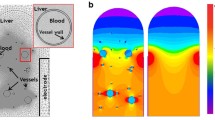Abstract
Purpose
Radio-frequency (RF) has been used to induce ablation and coagulation in liver for minimizing blood loss during liver resection. A multi-level tissue model that we have developed to investigate the changes in electrical properties of liver tissue during RF ablation.
Methods
The proposed computational model comprises of an equivalent circuit consisting of resistors and capacitors. The potential difference across the cells and the extracellular structure is used to help predicting the associated changes in tissue electrical property. Experiments were done to validate the proposed model and computer simulation.
Results
The changes in tissue mechanical properties were correlated with that of electrical property using experiments.
Conclusion
Knowledge of tissue properties changes in associated with changes at the cells and the extracellular structure can be used to optimize RF ablation and tissue division during surgery.
Similar content being viewed by others

References
Haemmerich D, Chachati L, Wright A, Mahvi D, Lee F, Webster JG (2003) Hepatic radiofrequency ablation with internally cooled probes: effect of coolant temperature on lesion size. IEEE Trans Biomed Eng 50: 4
Jiao LR, Navarra G, Weber J, Havlic R, Nicholls JP, Habib NA (2006) Radio frequency assisted liver resection: the habib’s technique. Liver Pancreat Disease Manag 574: 31–37
Milicevic M, Bulajic P (2006) Minimal blood loss radio frequency assisted liver resection technique. Liver Pancreat Disease Manag 574: 75–88
Pellici R, Percivale A, Pittaluga M, Pasqualini M, Profeti A, Paroldi A (2006) Radio frequency-assisted liver resection: experience of italian hepatic surgery unit. Liver Pancreat Disease Manag 574: 39–41
Moffitt T, Baker D, Kirkpatrick S, Prahl S (2002) Mechanical properties of coagulated albumin and failure mechanisms of liver repaired with the use of an argon beam coagulator with albumin. J Biomed Mater Res 63: 722–728
Dumas J III, Himel H IV, Kiser A, Quint S, Knisley S (2008) Myocardial electrical impedance as a predictor of quality of RF-induced linear lesions. Phys Meas 29: 1195–1207
Solazzo S, Liu Z, Lobo S, Ahmed M, Hines-Peralta A, Lenkinski R, Goldberg S (2005) Radiofrequency ablation: importance of background tissue electrical conductivity—an agar phantom and computer modeling study. Radiology 236: 495–502
Raicu V, Saibara T, Irimajiri A (1998) Dielectric properties of rat liver in vivo: a noninvasive approach using an open-ended coaxial probe at audio/radio frequencies. Bioelectrochem Bioenerg 47: 325–332
Kunii H, Kinouchi Y (1998) Parameter estimation of lumped element circuit for tissue impedance. In: Annual international conference of the IEEE engineering in medicine and biology society, vol 20, pp 3108–3111
Vasilkoski Z, Esser A, Gowrishankar T, Weaver J (2006) Membrane electroporation: the absolute rate equation and nanosecond time scale pore creation. Phys Rev E 74: 021904
Santago AC, Kemper AR, Mcnally C, Sparks KL, Duma SM (2009) Freezing affects the mechanical properties of bovine liver. In: 46th annual rocky mountain bioengineering symposium and 46th international ISA biomedical sciences instrumentation symposium 2009, vol 476, pp 24–29
Walsh JT Jr, Deutsch TF (1989) Pulsed CO2 laser ablation of tissue: effect of mechanical properties. IEEE Trans Biomed Eng 36: 1195–1201
Chui C, Kobayashi E, Chen X, Hisada T, Sakuma I (2004) Combined compression and elongation experiments and non-linear modeling of liver tissue for surgical simulation. Med Biol Eng Comput 42: 787–798
Fung YC, Liu SQ et al (1993) Remodeling of the constitutive equation while a blood vessel remodels itself under stress. J Biomech Eng 115(4B): 453–459
Kiss MZ, Varghese T, Hall TJ (2004) Viscoelastic characterization of in vitro canine tissue. Phys Med Biol 49: 4207–4218
Author information
Authors and Affiliations
Corresponding author
Rights and permissions
About this article
Cite this article
Huang, WH., Chui, CK., Kobayashi, E. et al. Multi-scale model for investigating the electrical properties and mechanical properties of liver tissue undergoing ablation. Int J CARS 6, 601–607 (2011). https://doi.org/10.1007/s11548-010-0537-1
Received:
Accepted:
Published:
Issue Date:
DOI: https://doi.org/10.1007/s11548-010-0537-1



